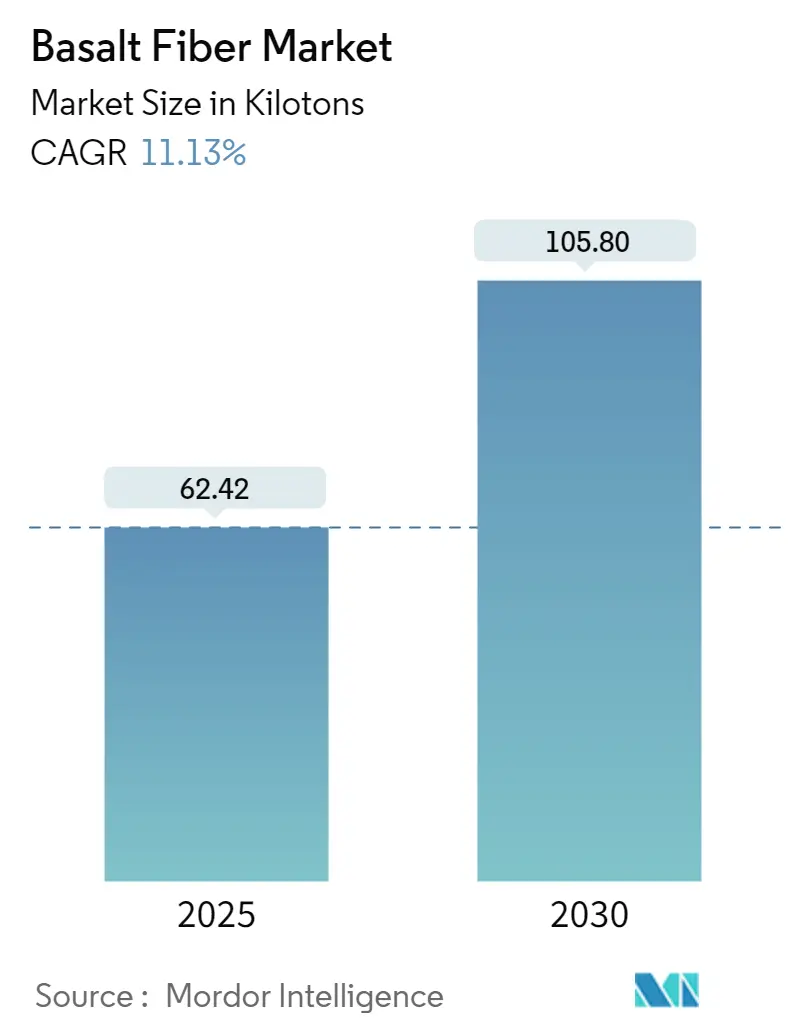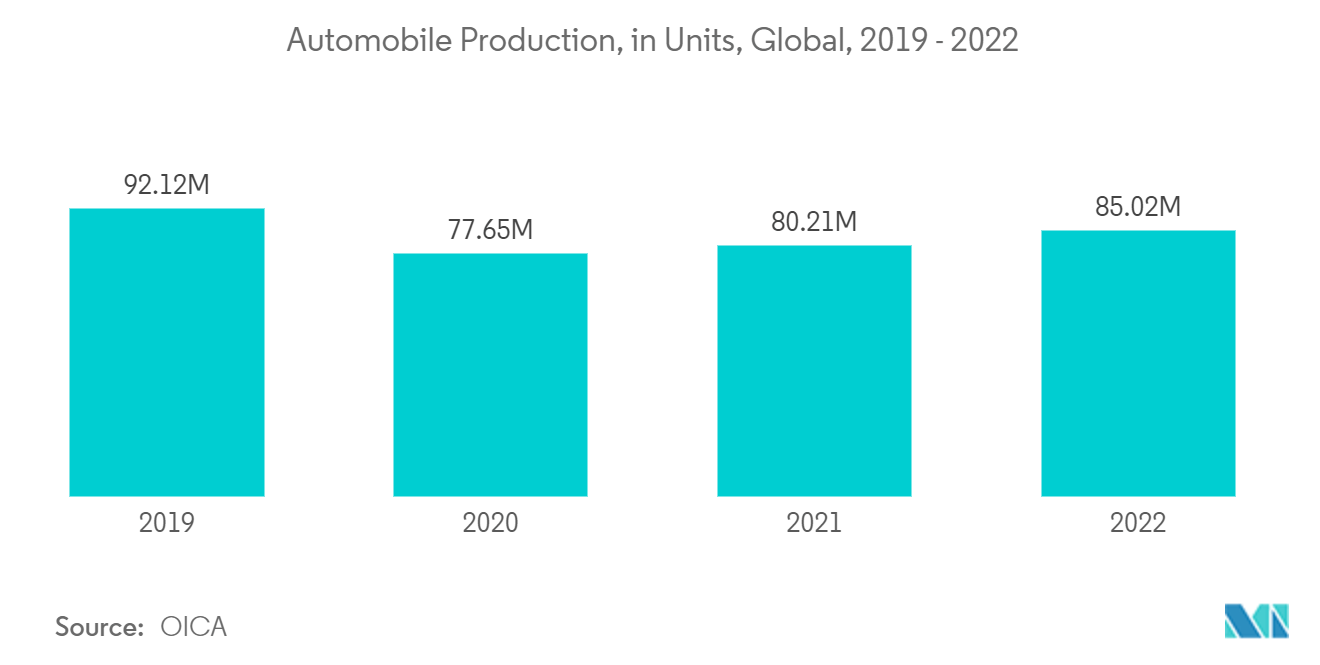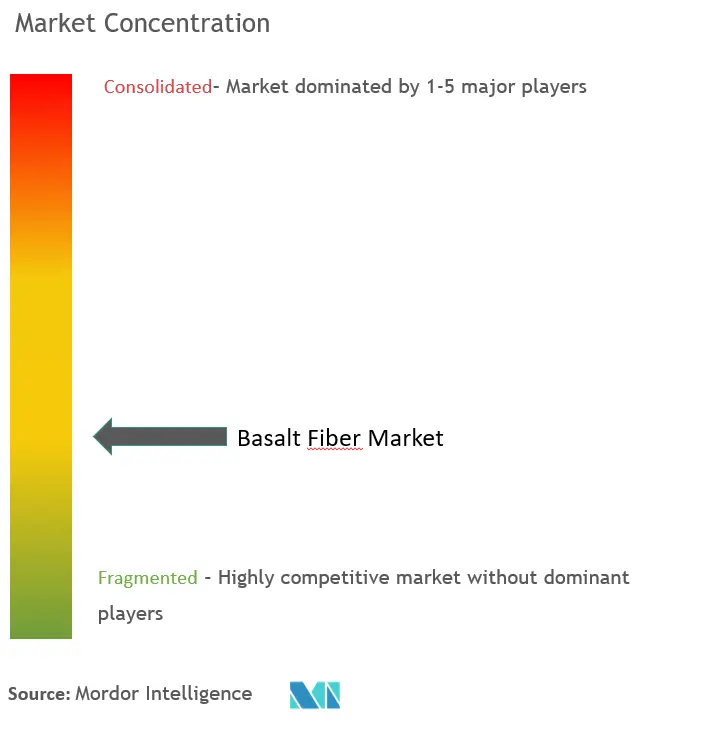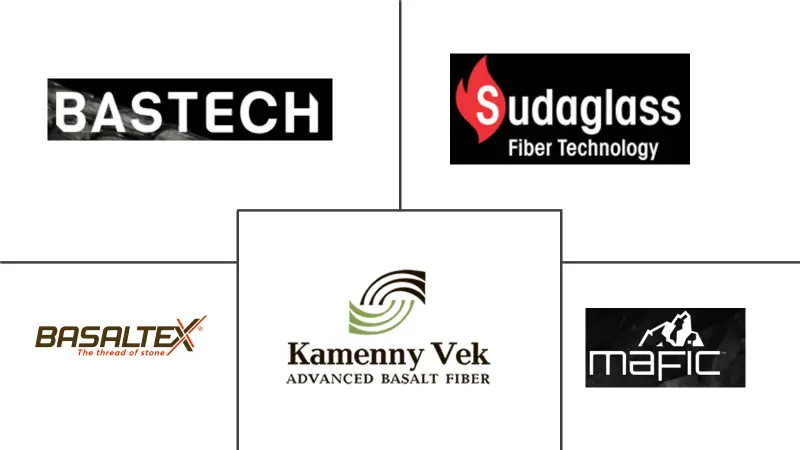
Basalt Fiber Market Analysis
The Basalt Fiber Market size is estimated at 62.42 kilotons in 2025, and is expected to reach 105.80 kilotons by 2030, at a CAGR of 11.13% during the forecast period (2025-2030).
The COVID-19 epidemic harmed the basalt fiber sector. Global lockdowns and severe rules enforced by governments resulted in a catastrophic setback as most production hubs were shut down. Nonetheless, the businesses were recovering since 2021 and are expected to rise significantly in the coming years.
- Over the short term, increasing demand from the automotive industry and spending on home remodeling and retrofitting activities are factors driving the studied market's growth.
- On the flip side, the easy availability of existing substitute products and fluctuations in raw material prices are expected to hinder the studied market's growth.
- However, increasing adoption of environmentally friendly materials will likely create opportunities for the market in the coming years.
- Asia-Pacific region is expected to dominate the market and is also likely to witness the highest CAGR during the forecast period.
Basalt Fiber Market Trends
Increasing Usage in the Automotive Industry
- Basalt fiber is environmentally friendly and includes good mechanical strength, resistance to high temperatures, durability, and chemical resistance. Due to all these properties and characteristics, basalt fiber is used in the automotive industry.
- In the automotive industry, basalt fiber is used for different parts such as headliners, CNG cylinders, fuel tanks, brake pads, clutch plates, exhausting systems, Muffler's filler, panels, screens, tire covers, interior and exterior parts based on fabrics, thermoplastic compound parts, and components.
- The rising population, improved living standards, and increased spending power will likely boost the demand for automobiles globally. For instance, according to the International Organization of Motor Vehicle Manufacturers (OICA), in 2022, the total number of passenger cars produced globally was 61.59 million units, which showed an increase of 8% compared to 2021. Therefore, an increase in the production of passenger cars is expected to create an upside demand for the basalt fiber market during the forecast period.
- Moreover, with the ease of supply chain issues in Germany, automobile production in the country observed an upside trend. For instance, according to OICA, in 2022, around 36,77,820 units of automobiles were produced in Germany, which shows an increase of 11% compared to 2021. Therefore, an increase in the production of automobiles in the country is expected to create an upside demand for the basalt fiber market.
- Furthermore, the United States is the second-largest vehicle sales and production market globally. For instance, according to The International Organization of Motor Vehicle Manufacturers (OICA), in 2022, automobile production in the United States amounted to 1,00,60,339 units, which showed an increase of 10% compared to 2021. As a result, an increase in automobile production is expected to create a significant demand for basalt fiber.
- Basalt fibers provide many benefits as filler for car mufflers showing great silencing properties and good resistance to thermal cycling. For instance, Toyota (one of the world's leading automotive companies) uses basalt fiber as sub- Muffler stuffing for their cars.
- Owing to all these factors, the demand for basalt fiber will likely grow globally during the forecast period.

Asia-Pacific Region to Dominate the Market
- The Asia-Pacific region dominated the global market share owing to the increasing automotive production and building and construction activities in the countries like China, Japan, and India.
- The automobile industry in China is experiencing shifting trends as consumer preference for battery-powered electric vehicles rises. The expansion of China's automotive sector is expected to benefit the ballast fiber market. According to the International Organization of Motor Vehicle Manufacturers (OICA), China is the world's largest automobile producer, accounting for nearly 34% of global volume. In 2022, the country produced 2,70,20,615 units of automobiles, registering an increase of 24% compared to 2,61,21,712 units in 2021. Therefore, increasing the production of automobiles is expected to create demand for basalt fiber.
- In India, increasing regulations on vehicle emissions, vehicle safety advancement, driver-assist system introduction, and rapidly growing logistics in the retail and e-commerce sectors significantly drove the demand for new and advanced Light commercial vehicles (LCVs). For instance, according to the International Organization of Motor Vehicle Manufacturers (OICA), in 2022, light commercial vehicle production in India amounted to 6,17,398 units, showing an increase of 27% compared to 2021.
- Moreover, increased investments and advancements in the automobile industry in India are expected to increase the consumption of ballast fiber products. For instance, in April 2022, Tata Motors announced plans to invest USD 3.08 billion in its passenger vehicle business over the next five years. This expansion is expected to include a positive impact on the basalt fiber market in the country.
- Furthermore, China holds the largest Asia-Pacific share of the construction market. The demand for basalt fiber is expected to rise throughout the forecast period due to rising investments and construction activity in the country. For instance, according to the National Bureau of Statistics (NBS) of China, in 2022, the output value of construction works in China amounted to CNY 27.63 trillion (USD 4,108.581 billion), an increase of 6.6% compared with 2021.
- The Japanese construction industry is expected to be booming as the country will host the World Expo in 2025 in Osaka, Japan. Furthermore, the ESR Cayman, OS Cosmosquare Data Centre, Osaka project, valued at USD 2,000 million, was Japan's largest building project, on which construction started in Q4 2022. The ESR Cayman, OS Cosmosquare Data Centre, Osaka project was announced in Q2 2021 in Osaka (City), Japan, with a completion date of Q1 2026. The second-largest project, the MLIT Japan, Shitara Dam Development, Aichi, with a project value of USD 570 million, began development in Q4 2022. The MLIT Japan, Shitara Dam Development, Aichi project is located in Japan and was announced in Q3 2022, with a completion date of Q4 2034.
- Due to all such factors, the region's basalt fiber market is expected to grow steadily during the forecast period.

Basalt Fiber Industry Overview
The Basalt Fiber Market is partially consolidated in nature. The major players in this market (not in a particular order) include Kamenny Vek, Basaltex, Sudaglass Fiber Technology, MAFIC, and BASTECH, among others.
Basalt Fiber Market Leaders
-
Basaltex
-
MAFIC
-
Kamenny Vek
-
Sudaglass Fiber Technology
-
BASTECH
- *Disclaimer: Major Players sorted in no particular order

Basalt Fiber Market News
- November 2022: Basalt Engineering, LLC has announced the receiving of FDOT facility approval which helped the company to gain the approval for Bastech Basalt FRP products to be utilized in transportation infrastructure projects of major Florida Department.
- January 2022: Basaltex, a leading producer of basalt fiber products based in Belgium, launched a new range of fiber fabrics designed for the aerospace and automotive industries. The new fabrics are lightweight, high-strength, and resistant to high temperatures, making them ideal for producing composites for aerospace and automotive applications.
Basalt Fiber Industry Segmentation
Basalt is igneous rock, and basalt fiber is produced using a blast furnace by melting volcanic rocks. It owns superior abrasion and high-temperature resistance and is extensively used as a structural composite. The basalt fiber market is segmented based on type, end-user industry, and geography. By type, the market is segmented into continuous and discrete. By end-user industry, the market is segmented into building and construction, automotive, marine, energy industry, and other end-user industries. The report offers market size and forecasts for 15 countries across major regions. For each segment, market sizing and forecasts are based on revenue (Tons) for all the above segments.
| Type | Continuous | ||
| Discrete | |||
| End-user Industry | Building and Construction | ||
| Automotive | |||
| Industrial | |||
| Marine | |||
| Energy Industry | |||
| Other (Sports, Chemical Industry, Petroleum Industry) | |||
| Geography | Asia-Pacific | China | |
| India | |||
| Japan | |||
| South Korea | |||
| Rest of Asia-Pacific | |||
| North America | United States | ||
| Canada | |||
| Mexico | |||
| Europe | Germany | ||
| United Kingdom | |||
| Italy | |||
| France | |||
| Rest of Europe | |||
| South America | Brazil | ||
| Argentina | |||
| Rest of South America | |||
| Middle East and Africa | Saudi Arabia | ||
| South Africa | |||
| Rest of Middle East and Africa | |||
Basalt Fiber Market Research FAQs
How big is the Basalt Fiber Market?
The Basalt Fiber Market size is expected to reach 62.42 kilotons in 2025 and grow at a CAGR of 11.13% to reach 105.80 kilotons by 2030.
What is the current Basalt Fiber Market size?
In 2025, the Basalt Fiber Market size is expected to reach 62.42 kilotons.
Who are the key players in Basalt Fiber Market?
Basaltex, MAFIC, Kamenny Vek, Sudaglass Fiber Technology and BASTECH are the major companies operating in the Basalt Fiber Market.
Which is the fastest growing region in Basalt Fiber Market?
Asia-Pacific is estimated to grow at the highest CAGR over the forecast period (2025-2030).
Which region has the biggest share in Basalt Fiber Market?
In 2025, the Asia-Pacific accounts for the largest market share in Basalt Fiber Market.
What years does this Basalt Fiber Market cover, and what was the market size in 2024?
In 2024, the Basalt Fiber Market size was estimated at 55.47 kilotons. The report covers the Basalt Fiber Market historical market size for years: 2019, 2020, 2021, 2022, 2023 and 2024. The report also forecasts the Basalt Fiber Market size for years: 2025, 2026, 2027, 2028, 2029 and 2030.
Our Best Selling Reports
Basalt Fiber Industry Report
Statistics for the 2025 Basalt Fiber market share, size and revenue growth rate, created by Mordor Intelligence™ Industry Reports. Basalt Fiber analysis includes a market forecast outlook for 2025 to 2030 and historical overview. Get a sample of this industry analysis as a free report PDF download.



